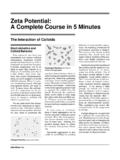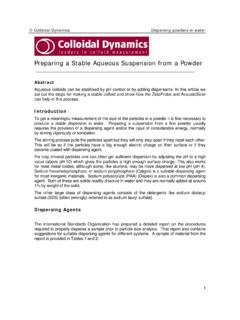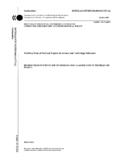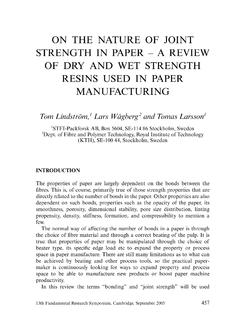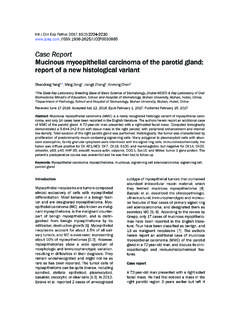Transcription of Everything you want to know - Zeta-Meter
1 Everything you want to know aboutCoagulation & Zeta-Meter , EditionApril 1993 Copyright Copyright by Zeta-Meter , Inc. 1993, 1991, 1990,1988. All rights reserved. No part of this publicationmay be reproduced, transmitted, transcribed, stored ina retrieval system, or translated into any language inany form by any means without the written permissionof Zeta-Meter , CommentsWe hope this guide will be helpful. If you have anysuggestions on how to make it better, or if you haveadditional information you think would help otherreaders, then please drop us a note or give us a editions will incorporate your , Middlebrook AvenuePO Box 3008 Staunton, Virginia 24402 Telephone(540) 886-3503 Toll Free (USA)(800) 333-0229 Fax(540) and written by Louis RavinaDesigned and illustrated by Nicholas MoramarcoChapter 4 _____ 19 Using Alum and Ferric CoagulantsTime Tested CoagulantsAluminum Sulfate (Alum)
2 PH EffectsCoagulant AidsChapter 5 _____ 25 Tools for Dosage ControlJar TestZeta PotentialStreaming CurrentTurbidity and Particle CountChapter 6 _____ 33 Tips on MixingBasicsRapid MixingFlocculationThe Zeta Potential Experts _____ 37 About Zeta-MeterIntroduction _____ iiiA Word About This GuideChapter 1 _____ 1 The Electrokinetic ConnectionParticle Charge Prevents CoagulationMicroscopic Electrical ForcesBalancing Opposing ForcesLowering the Energy BarrierChapter 2 _____ 9 Four Ways to FlocculateCoagulate, Then FlocculateDouble Layer CompressionCharge NeutralizationBridgingColloid EntrapmentChapter 3 _____ 13 Selecting PolyelectrolytesAn Aid or Substitute for Traditional CoagulantsPicking the Best OneCharacterizing PolymersEnhancing Polymer EffectivenessPolymer Packaging and FeedingInterferencesContentsA Word About This GuideThe removal of suspended matter fromwater is one of the major goals of watertreatment.
3 Only disinfection is used moreoften or considered more important. In fact,effective clarification is really necessary forcompletely reliable disinfection becausemicroorganisms are shielded by particles inthe usually involves: coagulation flocculation settling filtrationThis guide focuses on coagulation andflocculation: the two key steps which oftendetermine finished water control techniques have ad-vanced slowly. Many plant operators re-member when dosage control was basedupon a visual evaluation of the flocculationbasin and the clarifier.
4 If the operator seyeball evaluation found a deterioration inquality, then his common sense responsewas to increase the coagulant dose. Thisremedy was based upon the assumptionthat if a little did some good, then moreought to do better, but it often did competency of a plant operator de-pended on his years of experience with thatspecific water supply. By trial, error andoral tradition, he would eventually encoun-ter every type of problem and learn to dealwith instruments now help us under-stand and control the clarification ability to measure turbidity, particlecount, zeta potential and streaming currentmakes coagulation and flocculation more ofa science, although art and experience stillhave their make zeta meters and happen to be alittle biased in favor of zeta potential.
5 Inthis guide, however, we have attempted togive you a fair picture of all of the tools atyour disposal, and how you can put them Charge Prevents CoagulationThe key to effective coagulation and floccu-lation is an understanding of how individ-ual colloids interact with each other. Tur-bidity particles range from about .01 to 100microns in size. The larger fraction isrelatively easy to settle or filter. Thesmaller, colloidal fraction, (from .01 to 5microns), presents the real challenge. Theirsettling times are intolerably slow and theyeasily escape behavior of colloids in water is stronglyinfluenced by their electrokinetic colloidal particle carries a like charge,which in nature is usually negative.
6 Thislike charge causes adjacent particles torepel each other and prevents effectiveagglomeration and flocculation. As aresult, charged colloids tend to remaindiscrete, dispersed, and in the other hand, if the charge is signifi-cantly reduced or eliminated, then thecolloids will gather together. First formingsmall groups, then larger aggregates andfinally into visible floc particles which settlerapidly and filter 1 The Electrokinetic ConnectionCharged Particles repel each otherUncharged Particles are free to collide and 1 The Electrokinetic Connection Microscopic Electrical ForcesThe Double LayerThe double layer model is used to visualizethe ionic environment in the vicinity of acharged colloid and explains how electricalrepulsive forces occur.
7 It is easier to under-stand this model as a sequence of stepsthat would take place around a singlenegative colloid if the ions surrounding itwere suddenly stripped first look at the effect of the colloid onthe positive ions, which are often calledcounter-ions. Initially, attraction from thenegative colloid causes some of the positiveions to form a firmly attached layer aroundthe surface of the colloid . This layer ofcounter-ions is known as the Stern positive ions are still attracted bythe negative colloid but now they are re-pelled by the positive Stern layer as well asby other nearby positive ions that are alsotrying to approach the colloid .
8 A dynamicequilibrium results, forming a diffuse layerof counter-ions. The diffuse positive ionlayer has a high concentration near thecolloid which gradually decreases withdistance until it reaches equilibrium withthe normal counter-ion concentration a similar but opposite fashion, there is alack of negative ions in the neighborhood ofthe surface, because they are repelled bythe negative colloid . Negative ions arecalled co-ions because they have the samecharge as the colloid . Their concentrationwill gradually increase as the repulsiveforces of the colloid are screened out by thepositive ions, until equilibrium is againreached with the co-ion concentration Ways to Visualize theDouble LayerThe left view shows thechange in charge densityaround the colloid .
9 Theright shows the distributionof positive and negativeions around the LayerDiffuse LayerHighly Negative ColloidIons In Equilibrium With SolutionNegative Co-IonPositive Counter-Ion3 Double Layer ThicknessThe diffuse layer can be visualized as acharged atmosphere surrounding thecolloid. At any distance from the surface,its charge density is equal to the differencein concentration of positive and negativeions at that point. Charge density is great-est near the colloid and rapidly diminishestowards zero as the concentration of posi-tive and negative ions merge attached counter-ions in the Sternlayer and the charged atmosphere in thediffuse layer are what we refer to as thedouble thickness of the double layer dependsupon the concentration of ions in higher level of ions means more positiveions are available to neutralize the result is a thinner double the ionic concentration (bydilution, for example)
10 Reduces the numberof positive ions and a thicker double type of counter-ion will also influencedouble layer thickness. Type refers to thevalence of the positive counter-ion. Forinstance, an equal concentration of alumi-num (Al+3) ions will be much more effectivethan sodium (Na+) ions in neutralizing thecolloidal charge and will result in a thinnerdouble the concentration of ions or theirvalence are both referred to as double of Ion Density in the Diffuse LayerIncreasing the level of ions in solution reduces thethickness of the diffuse layer.
